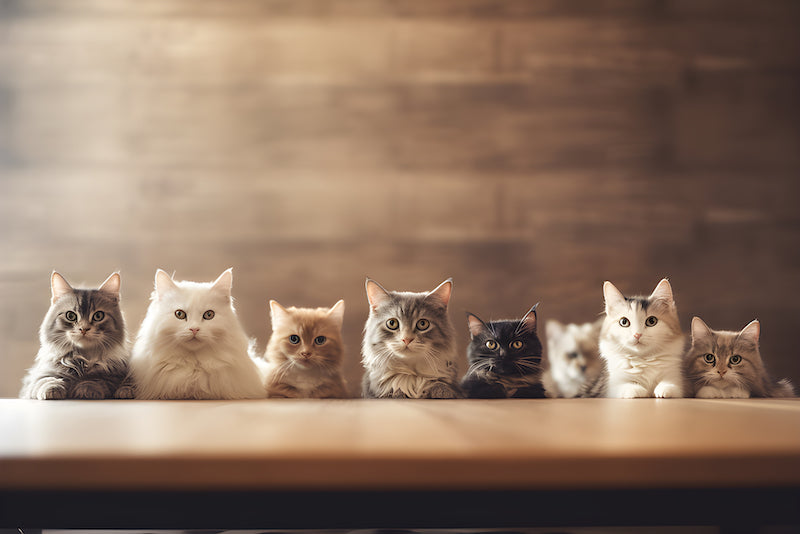
Which Cat Breed should I choose? Matching your Cat to your Lifestyle
Choosing the right cat breed is more than just picking a cute kitten from a litter; it's about finding a feline companion that will fit seamlessly into your life and home. Cats come in a variety of breeds, each with unique characteristics, temperaments, and care requirements. Some breeds are perfect for active households with kids and other pets, while others are better suited for quiet, single-person apartments. There are also adventurous breeds that love the outdoors and more laid-back breeds that prefer the comfort of a cozy indoor life. By considering your living situation, activity level, and family dynamics, you can choose a cat breed that will thrive in your home and bring joy to your life.
Additionally, no matter which breed you choose, keeping your cat safe is a top priority. Cat tracking collars are an invaluable tool for ensuring your feline friend is secure, whether they are exploring the backyard or lounging indoors. These devices can provide peace of mind, allowing you to monitor your cat's location and well-being at all times. In this guide, we will explore how to match different cat breeds to various lifestyles, ensuring a harmonious and fulfilling relationship between you and your furry companion.
Considering Rescue Cats and Mixed Breeds
While specific cat breeds offer unique traits and characteristics, it's important to remember the wonderful cats available at shelters and rescue organizations. Rescue cats and mixed breeds make incredible pets and often have loving, affectionate personalities that rival any purebred. By adopting a rescue cat, you not only provide a deserving animal with a forever home but also contribute to the broader effort of reducing the number of homeless pets.
Benefits of adopting a rescue cat
- Saving lives: By adopting, you are giving a second chance to a cat in need.
- Unique personalities: Rescue cats often have distinct and charming personalities shaped by their experiences.
- Health checks: Shelters typically ensure that cats are spayed/neutered, vaccinated, and health-checked before adoption.
Things to consider when adopting a rescue cat
- Health and history: Be aware that some rescue cats might have unknown health histories or past traumas. Work with shelter staff to understand any special needs.
- Adjustment period: Rescue cats may need time to adjust to their new environment. Patience and love are key.
- Mix of traits: Mixed breed cats can offer a delightful combination of traits from various breeds, making them unique and special companions.
Rescue cats can fit into any of the categories discussed in this guide—family-friendly breeds, apartment living kitties, or active and outdoor cats. They bring joy, love, and companionship, and adopting one is a rewarding experience that supports animal welfare.
1. Understanding Your Lifestyle
Before selecting the right breed of cat for your home, it's essential to consider the key aspects of your lifestyle:

- Suburban vs. Urban Living: The amount of space and the environment you live in can greatly influence the best cat breed choice for you. For example, breeds that require more space to roam and play might be better suited for suburban living, while more laid-back breeds can thrive in urban apartments.
- Active vs. Sedentary Lifestyles: Some breeds need more physical activity and mental stimulation than others. If you lead an active lifestyle, a breed that enjoys playtime and exercise might be a good fit. Conversely, if you live a more relaxed life, a calmer breed would be more appropriate.
- Family Dynamics: If you have children or other pets, it's important to choose a breed known for being friendly and tolerant. Some breeds are more social and enjoy interaction, making them great for busy households, while others prefer a quieter, more solitary environment.
2. Family-Friendly Cat Breeds
When it comes to choosing a breed of cat to join your family, it's crucial to consider breeds known for their friendly, tolerant, and social nature. These cats are typically patient with children, adaptable to noisy and busy environments, and enjoy interaction with multiple family members. Integrating these breeds into a family home can create a harmonious and loving environment where both the cats and family members thrive.
The following cat breeds are particularly known for their compatibility with families and children:
-
Ragdoll

Ragdolls are renowned for their gentle and affectionate nature. They are particularly known for their calm demeanor and tendency to go limp when held, hence their name. Ragdolls are great with children and other pets, making them a perfect addition to a family setting. Their sociable and friendly nature means they love being involved in family activities and are content to be cuddled and petted by kids.
- Maine Coon
Maine Coons are one of the largest domestic cat breeds, but don't let their size intimidate you. They are friendly, playful, and incredibly tolerant of children. Known as "gentle giants," Maine Coons are affectionate and enjoy being part of the family. They are also very sociable with other pets and adapt well to different home environments. Their playful nature makes them a hit with kids, and they often engage in interactive play.
- Siamese
Siamese cats are highly social and thrive on interaction with their human companions. They are affectionate, vocal, and enjoy being the center of attention, making them excellent family pets. Siamese cats are known for their strong bonds with their family members and their ability to get along well with children and other pets. They are energetic and enjoy playing, making them a lively addition to any family home.
Characteristics of family-friendly cat breeds:
- Gentle and patient with children.
- Sociable and enjoy interaction with multiple family members.
- Affectionate and enjoy being cuddled and petted.
- Adaptable to living with other pets.
Tips for integrating family-friendly cats:
- Create a safe and stimulating environment with toys and climbing structures.
- Establish a routine to help your cat adjust to family life.
- Teach children how to interact gently and respectfully with the cat.
- Provide quiet spaces where the cat can retreat if they need some alone time.
3. Best Cat Breeds for Apartment Living
Living in an apartment doesn't mean you can't have a cat. Some breeds adapt exceptionally well to smaller living spaces due to their calm demeanor and lower activity levels. These breeds are generally quieter, more content with indoor life, and require less space to roam, making them ideal companions for apartment dwellers.
These cat breeds adapt well to smaller living spaces:
-
Scottish Fold

Scottish Folds are distinguished by their unique folded ears and gentle, affectionate nature. They are quiet and adaptable, making them well-suited for apartment living. Scottish Folds are known for their sweet temperament and enjoy being around their human companions. Their low exercise needs and quiet demeanor make them a great choice for smaller living spaces.
-
British Shorthair
British Shorthairs are known for their calm and easygoing nature. They are low-energy cats that enjoy lounging around, making them perfect for indoor living. Their quiet disposition means they are less likely to disturb neighbors, and their independent nature allows them to be content with being alone for longer periods. British Shorthairs are affectionate without being overly demanding, making them ideal for apartment life.
-
Devon Rex
Devon Rex cats are playful and enjoy the indoor environment. They have a unique appearance with their wavy coat and large ears. Despite their playful nature, Devon Rex cats have minimal shedding, making them easier to manage in an apartment setting. They are affectionate and enjoy interactive play, but their small size and adaptability make them perfect for apartment living.
Characteristics of apartment-friendly breeds:
- Low energy levels and minimal exercise needs.
- Affectionate and adaptable to indoor living.
- Quiet and less likely to disturb neighbors.
Tips for keeping apartment cats happy:
- Provide plenty of vertical spaces like cat trees or cat shelves.
- Play with your cats with interactive toys to keep them mentally stimulated.
- Keep the litter box clean and place it in a quiet, accessible location.
4. Active and Outdoor Cat Breeds
For those with an active lifestyle or who live in environments where outdoor exploration is possible, certain cat breeds are well-suited for these conditions. These breeds have higher energy levels, enjoy physical activity, and thrive with plenty of stimulation and adventure. It's important to ensure their safety when they explore outdoors, and using a cat tracking collar can provide peace of mind. These breeds thrive with activity and outdoor exploration:
-
Bengal
Bengals are energetic and adventurous cats. They love climbing, exploring, and engaging in active play. Their sleek, muscular bodies and striking coat patterns make them visually stunning, but it's their lively nature that truly stands out. Bengals require plenty of mental and physical stimulation, making them ideal for active households. They enjoy interactive play and can be trained to walk on a leash, providing an excellent opportunity for outdoor adventures.
-
Abyssinian
Abyssinians are inquisitive and active cats known for their playful and curious nature. They enjoy interactive play and exploring their surroundings. Abyssinians are agile and love to climb, making them well-suited for households that can provide plenty of stimulation and adventure. Their social nature means they enjoy spending time with their human companions and can adapt to both indoor and outdoor environments.
-
Siberian

Siberian cats are agile and adventurous, enjoying outdoor activities and physical play. They are known for their friendly and affectionate nature, making them great companions for families. Their adventurous spirit means they enjoy exploring the outdoors, but they also adapt well to indoor living when provided with enough stimulation.
Characteristics of Active and Outdoor Cat Breeds:
- High energy levels and love for physical activity.
- Enjoy exploring and climbing.
- Require plenty of mental and physical stimulation.
- Adaptable to both indoor and outdoor environments.
- Sociable and enjoy spending time with their human companions.
Tips for Safely Introducing Outdoor Cats:
- Gradually introduce them to the outdoors using a harness and leash
- Use a cat tracking collar to monitor their location and ensure their safety.
- Create a secure outdoor area where they can explore without escaping.
- Provide plenty of interactive toys and climbing structures indoors to keep them entertained.
- Ensure they are up-to-date on vaccinations and parasite prevention before allowing them outside.
5. Conclusion
Choosing a cat breed that matches your lifestyle is essential for a happy and fulfilling relationship with your feline friend. Providing the right environment and care tailored to your cat’s breed-specific needs is crucial. Engage them with appropriate toys, ensure they have plenty of vertical space, and offer a variety of scratching posts and cozy spots for relaxation. Regular playtime and maintaining a clean litter box area also contribute to their overall well-being. Take the time to understand their unique characteristics and needs, and you’ll be rewarded with a loving, loyal friend for years to come.
 UK
UK
 USA
USA
 GLOBAL
GLOBAL
